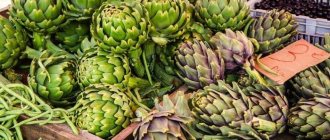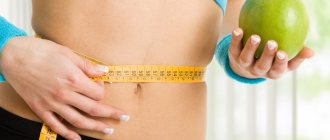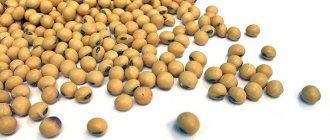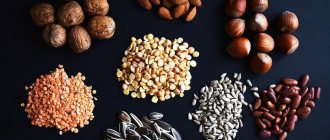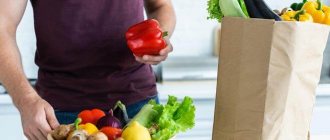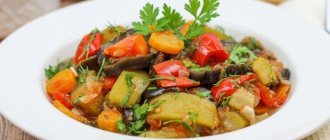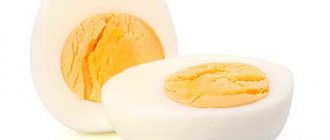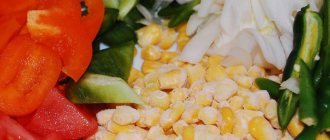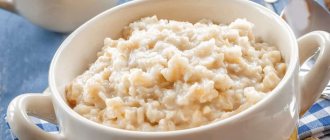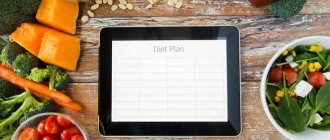Vegetables are an integral part of the human diet. The indispensability of the product is explained by its excellent taste and nutritional properties, therapeutic and preventive effects on the body. The carbohydrates, amino acids, vitamins, and active elements contained in vegetables are easily digestible, so the product has a high nutritional value.
Analysis of the energy value of a product gives an understanding of how many calories are in vegetables. The low calorie content of most fresh vegetables allows them to be included in the diet of people who lead a healthy lifestyle and watch their figure.
Heat treatment of the product promotes the destruction of dietary fiber, which increases the rate of release of carbohydrate energy. Therefore, the calorie content of stewed vegetables increases.
Meat products
Meat products contain practically no carbohydrate component; they are rich in proteins and fats.
Animal fat, if consumed in excess, can cause increased cholesterol levels and the development of atherosclerosis. However, you should not give up meat products - meat and eggs contain a full range of essential amino acids that the body requires to form muscle mass.
For a healthy diet, choose lean meats and egg whites. Calorie table for meat products:
| Meat products | Calorie content per 100 g of raw product | Calorie content per 100 g of prepared product |
| Beef | 187 | Stewed: 232 Fried: 384 |
| Pork | 265 | Stewed: 350 Fried: 489 |
| Mutton | 294 | Stewed: 268 Fried: 320 |
| Chicken breasts | 113 | Boiled: 137 Fried: 157 |
| Chicken legs | 158 | Boiled: 170 Fried: 210 |
| Duck | 308 | Baked: 336 |
| Goose | 300 | Baked: 345 |
| Eggs | 155 | Fried: 241 Boiled: 160 |
| Egg white | 52 | Boiled: 17 Fried: 100 |
| Egg yolk | 322 | Boiled: 220 |
| Ham | 365 | |
| Boiled sausage | 250 | |
| Smoked sausage | 380 | |
| Sausages | 235 |
Dairy
Milk is a source of protein and some fat-soluble vitamins and minerals.
Fermented milk products supply the body with beneficial probiotics that improve intestinal function.
Cottage cheese provides the body with the slow-moving protein casein, and cheese is the record holder among all products for calcium content. Calorie content of dairy products per 100g:
| Dairy | Calorie content per 100 g of product |
| Skim milk | 31 |
| Milk 3.2% | 60 |
| Milk 6% | 68 |
| Low-fat cottage cheese | 80 |
| Cottage cheese 2.5% | 103 |
| Cottage cheese 9% | 159 |
| Yogurt 1.5% | 51 |
| Hard cheese | 370 |
| Hard cheese with reduced fat content | 260 |
| Processed cheese | 215 |
| Full fat kefir | 60 |
| Kefir 1% | 38 |
| Butter | 750 |
| Sour cream 10% | 115 |
| Sour cream 20% | 210 |
Calorie content of oils, table
| Product | Water | Squirrels | Fats | Carbohydrates | Kcal |
| Rendered fat | 0,2 | 0 | 99,8 | 0 | 899 |
| Pork bacon | 5,5 | 1,3 | 92,9 | 0 | 819 |
| Milk margarine | 15,6 | 0,2 | 82,4 | 0,9 | 745 |
| Creamy margarine | 15,7 | 0,5 | 86 | 2,2 | 815 |
| Mayonnaise | 24 | 3,2 | 65 | 2,5 | 634 |
| Vegetable oil | 0,1 | 0 | 99,9 | 0 | 901 |
| Butter | 15,7 | 0,6 | 82,6 | 0,8 | 752 |
| Ghee | 1 | 0,2 | 99 | 0,5 | 888 |
Fish and seafood
Fish is rich in proteins and fats, however, as opposed to fats from meat, fish oils are beneficial for blood vessels and the heart due to their significant content of omega-3 fatty acids.
Seafood contains almost no fat - it is a high-quality protein product. Calorie content of fish and seafood in the table:
| Fish and seafood | Calorie content per 100 g of raw product | Calorie content per 100 g of prepared product |
| Red caviar | 250 | |
| Black caviar | 235 | |
| Shrimps | 95 | Boiled: 95 |
| Squid | 75 | Boiled: 75 |
| Cancers | 75 | Boiled: 75 |
| Carp | 45 | Roasted: 145 |
| Chum salmon | 138 | Roasted: 225 |
| Salmon | 142 | Fried: 155 Smoked: 385 |
| Bream | 48 | Boiled: 126 Dried: 221 |
| Pollock | 70 | Roasted: 136 |
| Perch | 95 | Stewed: 120 |
| Herring | 57 | Salty: 217 |
| Sprats | 250 |
Vegetables
Almost all vegetables are low in calories, with the exception of starchy vegetables such as potatoes and corn.
Vegetables contain insoluble fiber, which is not absorbed in the digestive tract, but makes it work properly. Give preference to fresh vegetables or process them minimally. Calorie content of vegetables:
| Vegetables | Calorie content per 100 g of raw product | Calorie content per 100 g of prepared product |
| cucumbers | 15 | Salty: 11 |
| Tomatoes | 20 | Salty: 32 |
| Onion | 43 | Roasted: 251 |
| Zucchini | 24 | Stewed: 40 |
| Eggplant | 28 | Stewed: 40 |
| Potato | 80 | Boiled: 82 Fried: 192 Baked: 90 |
| Cabbage | 23 | Stewed: 47 Salted: 28 |
| Broccoli | 28 | Boiled: 28 |
| Carrot | 33 | Stewed: 46 |
| Mushrooms | 25 | Fried: 165 Pickled: 24 Dried: 210 |
| Pumpkin | 20 | Baked: |
| Corn | 101 | Boiled: 123 Canned: 119 |
| Green pea | 75 | Boiled: 60 Canned: 55 |
| Greenery | 18 | |
| Beet | 40 | |
| bell pepper | 19 | |
| Radish | 16 |
Table of negative calorie foods
Cucumbers are a negative calorie food
Nowadays, you can hear about negative calorie foods for weight loss on TV or among people. What are these foods and what does negative calorie mean?
These are food products for the processing of which our body spends more energy resources than it receives. This all happens because our digestive tract has to work hard to digest the dietary fiber and fiber from these foods.
Table of foods with negative calorie content:
| Products | Kcal |
| Spinach | 21 |
| bell pepper | 26 |
| Apples | 44 |
| Lemon | 30 |
| Salad | 15 |
| Rhubarb | 16 |
| Radish | 20 |
| Sea kale | 5 |
| Tomatoes | 15 |
| Grapefruit | 33 |
| Eggplant | 25 |
| Carrot | 31 |
| cucumbers | 10 |
Important: Create a menu for weight loss and include these products in it. They will help you lose excess weight without any effort.
Fruits and berries
Fresh fruits, like vegetables, contain a large amount of fiber. In addition, fruits and berries are rich in beneficial vitamins and antioxidants, which support the proper functioning of all systems in the body and prevent the development of many diseases.
Fruits contain natural sugar - fructose, so if you are watching your carbohydrate intake, the amount of fruit in your diet should be reduced. See the table for the lowest calorie fruits and berries:
| Fruits | Calorie content per 100 g of raw product | Calorie content per 100 g of prepared product |
| Apples | 45 | Jam: 265 Dried: 210 |
| Pear | 42 | Jam: 273 Dried: 249 |
| Apricots | 47 | Dried apricots: 290 |
| Bananas | 90 | Dried: 390 |
| Oranges | 45 | Candied fruits: 301 |
| Tangerines | 41 | Candied fruits: 300 |
| Lemons | 30 | Candied fruits: 300 |
| Grapefruit | 30 | Candied fruits: 300 |
| Cherry | 25 | Jam: 256 |
| Plum | 44 | Jam: 288 Dried: 290 |
| Raspberries | 45 | Jam: 273 |
| Strawberry | 38 | Jam: 285 |
| Currant | 43 | Jam: 284 |
| Gooseberry | 48 | Jam: 285 |
| Grape | 70 | Raisins: 270 |
| Kiwi | 59 | Dried: 285 |
| Mango | 67 | Dried: 314 |
| Peaches | 45 | Jam: 258 |
| Melon | 45 | Candied fruits: 319 |
| Watermelon | 40 | Candied fruits: 209 |
| A pineapple | 44 | Dried: 268 |
| Pomegranate | 52 | |
| Avocado | 100 |
Beverages
Water, coffee and tea without milk and without sugar have zero calories.
All other drinks are quite energy-intensive and should be taken into account when calculating daily caloric content. Pay attention to the calorie content of alcoholic drinks. The alcohol contained in them has an estimated energy content of 7 kilocalories per 1 gram. This is less than fats, but almost twice as much as proteins and carbohydrates.
| Vegetables | Calorie content per 100 g of product |
| Apple juice without sugar | 42 |
| Orange juice without sugar | 36 |
| carrot juice | 28 |
| Tomato juice | 21 |
| Fruit compote | 85 |
| Tea with milk and sugar | 43 |
| Coffee with milk and sugar | 58 |
| Cocoa | 70 |
| Beer | 30 |
| Kvass | 30 |
| Coca Cola | 42 |
| Lemonade | 26 |
| Fanta | 48 |
| Dry wine | 68 |
| Sweet wine | 160 |
| Liquor | 327 |
| Cognac | 239 |
| Vodka | 235 |
Mushroom calorie table
Calorie content of mushrooms per 100 grams
If you like to pick and eat other mushrooms, then use this calorie content table per 100 grams:
| Product | Water | Squirrels | Fats | Carbohydrates | Kcal |
| Fresh oyster mushrooms | 75 | 2,5 | 0,3 | 6,5 | 38 |
| Fresh chanterelles | 72 | 1,6 | 1,1 | 2,3 | 19 |
| Dried chanterelles | 15 | 22,3 | 7,5 | 23,5 | 259 |
| Fresh boletus | 82 | 2,3 | 0,4 | 1,5 | 8 |
| Fresh honey mushrooms | 78 | 2,1 | 1,1 | 2,9 | 15 |
| Portobello raw | 74 | 2,3 | 0,1 | 3,5 | 23 |
| Fresh morels | 65 | 1,5 | 0,3 | 4,1 | 25 |
| Fresh truffles | 67 | 5,8 | 0,4 | 5,2 | 50 |
| Chernushki | 86 | 1,4 | 0,3 | 0,1 | 8 |
| Fresh champignons | 81 | 4,1 | 0,9 | 0,8 | 26 |
| Shiitake fresh | 79 | 4,2 | 0,9 | 0,9 | 25 |
| Dried shiitake | 22 | 19,2 | 0 | 62,5 | 330 |
Important: Now you can cook even the most delicious dishes that contain mushrooms in your recipe.
Please note: Any dried mushrooms are very high in calories, so use them in your diet in minimal quantities. At the same time, fresh mushrooms should not be eaten in large quantities, despite their low calorie content, since they contain a lot of carbohydrates.
Nuts and seeds
Nuts and seeds are rich in plant proteins, fats and fiber.
This is a very high-calorie product, but you should not completely abandon it, since nuts contain many nutrients.
You can sprinkle the seeds on your salad, and you can take a handful of nuts with you and use them as a healthy snack. How many calories are in available nuts and seeds:
| Nuts | Calorie content per 100 g of raw product | Calorie content per 100 g of prepared product |
| Almond | 600 | Roasted: 578 |
| Walnut | 650 | Roasted: 654 |
| Hazelnut | 670 | Roasted: 657 |
| Pistachios | 620 | Salty: 556 |
| Cashew | 643 | Roasted: 572 |
| Sunflower seeds | 580 | Fried: 578 |
| Pumpkin seeds | 556 | Fried: 550 |
| Sesame | 565 | Roasted: 582 |
| Peanut | 470 | Roasted: 578 |
| Cedar | 620 | Roasted: 673 |
Vegetable side dish “European”
In European countries, especially in Great Britain, the side dish that we will prepare is very popular. All components for it are available at any time of the year. It’s delicious, and it gives us so many “benefits”! Be sure to try cooking it!
Ingredients:
- carrots - six fruits (small size);
- potatoes - two root vegetables;
- Brussels sprouts – 150 g;
- red onion - head;
- bell pepper – three pieces;
- garlic cloves – three pieces;
- beets - one root vegetable;
- mushrooms - five pieces;
- salt (preferably sea salt) – one teaspoon. spoon;
- olive oil – 25 ml;
- pepper blend;
- honey - one table. spoon;
- balsamic vinegar - three tablespoons. spoons.
Preparation:
- We will prepare the products we need. It is better to take peppers of different colors, then the dish will play with bright colors.
- Clean the peppers, rinse and dry.
- Chop medium-sized peppers into strips.
- Peel and wash the carrots. We do not cut off the tails completely (as in the photo).
- Remove the top leaves from the cabbage (this way it won’t taste bitter). Let's cut the heads of cabbage down to the ground.
- Clean and wash the beets. Let's cut it into circles.
- Clean, rinse and dry the mushrooms.
- Cut the mushrooms into not too small slices.
- Let's clean the onion. Let's chop it into half rings. Let's separate them from each other.
- Peel the garlic cloves and cut them into slices.
- Let's peel the potatoes. Cut it into bars along the root crop. By the way, you can complement the taste of the side dish with parsnips and pumpkin pulp.
- Let's prepare salt and a blend of peppers. Sea salt is needed, since under its influence vegetables will not change their color.
- Place assorted vegetables and mushrooms on a baking sheet.
- Salt and sprinkle with pepper.
- Pour the workpiece with olive oil. Let's stir well.
- Place a couple or three sprigs of rosemary on top of the assorted vegetables.
- Bake the side dish at one hundred and seventy degrees for thirty minutes.
- In the meantime, let's make the sauce. For it we need honey and balsamic vinegar.
- Combine vinegar and honey in a deep bowl and stir until smooth.
- After thirty minutes, pour the prepared sauce over our side dish. Stir well and bring the mixed vegetables to readiness.
- Serve our side dish while it is hot.
Cereals and legumes
Cereals supply the complex carbohydrates the body needs for a balanced diet.
Consuming slow-acting carbohydrates prevents a sharp rise in blood glucose and keeps you full for several hours. In addition to carbohydrates, legumes contain a large amount of vegetable protein. Calorie content of cereals and legumes per hundred grams:
| Cereals | Calorie content per 100 g of dry product | Calorie content per 100 g of prepared product |
| Buckwheat | 346 | Porridge on water: 132 |
| White rice | 330 | Porridge with water: 97 Porridge with milk: 116 |
| Brown rice | 330 | Porridge on water: 97 |
| Lentils | 310 | Boiled: 111 |
| Beans | 328 | Boiled: 123 |
| Millet | 351 | Porridge with water: 100 Porridge with milk: 135 |
| Semolina | 340 | Porridge with milk: 98 |
| Pearl barley | 342 | Porridge on water: 106 |
| Oats | 374 | Porridge with water: 88 Porridge with milk: 102 |
| Cereals | 365 | Porridge with water: 76 Porridge with milk: 100 |
Pastries and sweets
These products have virtually no nutritional value, but they are very energy-intensive.
When losing weight, it is recommended to reduce the amount of flour products and sweets to a minimum or avoid them altogether. Such products do not contain nutrients, have a significant glycemic index, and supply the body with fast carbohydrates and “empty” calories, which are likely to be stored as fat. Calorie content of sweets:
| Bakery | Calorie content per 100 g of product |
| Sugar | 398 |
| White bread | 265 |
| Rye bread | 210 |
| Pasta | 350 |
| Butter pastries | 300 |
| Caramel | 370 |
| Chocolate candies | 569 |
| Milk chocolate | 550 |
| Bitter chocolate | 539 |
| Condensed milk | 320 |
| Ice cream | 220 |
| Honey | 314 |
| Marmalade | 293 |
| Marshmallow | 304 |
| Waffles | 450 |
Calorie content of mushrooms, table
Mushrooms are a low-calorie food product.
Mushrooms contain many useful substances and microelements. This product is high in protein and some types have little or no carbohydrates.
Important: Nutritionists always include mushrooms in protein diets. But, if a person monitors his weight and wants to consolidate the results obtained when losing weight, he needs to know the calorie content of this food product.
The most popular types of mushrooms that residents of our country like to eat are porcini mushrooms, boletus mushrooms and aspen mushrooms. Many lovers of quiet hunting also collect russula.
Sauces
Sauces and various dressings are usually added to salads or used with meat. Since many of them are quite high in calories, this fact should be taken into account when calculating your daily calorie intake. Calorie table for sauces:
| Sauces | Calorie content per 100 g of finished product |
| Sunflower oil | 900 |
| Olive oil | 824 |
| Ketchup | 80 |
| Vinegar | 32 |
| Mayonnaise light | 260 |
| Mayonnaise | 625 |
The best foods for weight loss
The main goal when losing weight is to saturate the body with nutrients without adding unnecessary calories.
Pay attention to products with low fat content; the method of preparing the dish also matters. It is preferable to steam, boil or bake food in the oven.
The best foods for weight loss in the table:
| Product category | Recommendations |
| Meat products | Choose boiled chicken breasts or cook lean beef or lean pork in the oven. The egg white should be separated from the yolk to reduce the calorie content of the product. Avoid all processed meats. |
| Dairy | Opt for low-fat milk, cottage cheese, yogurt and kefir to fill your body with protein without extra calories. |
| Fish and seafood | Steamed or grilled fish and seafood can be added to the diet without restrictions. |
| Vegetables | Reduce your consumption of potatoes and corn. Prefer using fresh vegetables for salads or steaming them. |
| Fruits | Eat fruits only fresh. Fresh fruits are low in calories, with the exception of avocado and banana, but contain a lot of fructose, which is a fast carbohydrate. If you want to lose weight, consider this fact. |
| Beverages | Water, coffee and tea without milk and without sugar in unlimited quantities. Other drinks should be avoided during weight loss. |
| Nuts and seeds | No more than 10 nuts per day, taking into account their calorie content in the daily diet. |
| Cereals and legumes | Cook porridge in water. You should not avoid complex carbohydrates when losing weight - without them, you will quickly break down and break your diet. |
| Pastries and sweets | Avoid while losing weight and limit after this period. |
| Sauces | To dress the salad, just sprinkle it with vegetable oil, vinegar or lemon juice. |
Video about the health benefits of vegetables
We invite you to watch a short but very informative video about the beneficial properties of vegetables.
We think that you will be interested in learning about the calorie content of white cabbage and what you need to do in order to reduce the calorie content of the finished dish.
- The calorie content of boiled corn is relatively low, so it is recommended for consumption by all its lovers. But remember that only what is consumed in moderation is beneficial.
- The calorie content of potatoes is low, but due to the fact that they have a large amount of starch, it is recommended to exclude them from your menu during weight loss diets.
- The calorie content of bell pepper is low, this product is very useful for the human body, therefore it is recommended for consumption by almost everyone.
Tell us how you feel about vegetables, have you ever tried a vegetable diet, what plants do you like best?
Author of the publication
The Best Foods for Mass Gain
To build muscle mass, you should increase your daily caloric intake. This, however, does not mean that you need to eat all high-calorie foods in a row.
For a healthy diet, focus on complete proteins and complex carbohydrates.
| Product category | Recommendations |
| Meat products | Along with boiled breasts, make scrambled eggs, as well as steaks and chops from lean meat. |
| Dairy | Any dairy products are allowed, but it is better to focus on whey protein and cottage cheese as a source of casein. |
| Fish and seafood | Boiled, fried and steamed fish and seafood. |
| Vegetables | Limit your consumption of fresh vegetables, as fiber will prevent the food you eat from being absorbed. |
| Fruits | Limit sugary fruits for fast carbohydrates or use them post-workout. |
| Beverages | Avoid alcohol - it suppresses protein synthesis in the body and reduces the ability of muscles to recover after exercise. |
| Nuts and seeds | Limit your serving size as nuts are difficult for the body to digest and will cause discomfort in the digestive tract if consumed in large quantities. |
| Cereals and legumes | Oatmeal, buckwheat and lentils have a moderate glycemic index and provide the body with many beneficial microelements. |
| Pastries and sweets | Limit these foods due to fast carbohydrates. Can be used as a cheat meal or immediately after training. |
| Sauces | Give preference to vegetable oil - artificially prepared sauces contain a lot of preservatives and salt. |
Start a discussion Cancel reply
Calorie content of alcohol, table
Alcoholic drinks are high-calorie foods.
Alcohol is high-calorie drinks. Therefore, nutritionists advise not to drink alcohol while losing weight.
Important: Of course, you won’t be able to completely limit your alcohol consumption. A person can afford to drink a glass of wine on a holiday or 50 grams of strong drink.
To find out which alcoholic drinks are best to choose for a celebration, the table of calorie content of alcohol will help:
| Drink | Kcal | Squirrels | Fats | Carbohydrates |
| Beer 1.8% alcohol | 28 | 0,2 | 0 | 4,2 |
| Beer 4.5% alcohol | 44 | 0,5 | 0 | 3,8 |
| White wine 10% | 65 | 0 | 0 | 4,3 |
| Red wine 12% | 75 | 0 | 0 | 2,2 |
| Absinthe | 82,1 | 0 | 0 | 7,9 |
| Champagne 12% | 87 | 0,2 | 0 | 4,9 |
| Sweet white wine 13.5 | 97 | 0 | 0 | 5,8 |
| Sherry 20% | 125 | 0 | 0 | 2,9 |
| Sake 20% | 133 | 0,5 | 0 | 4,9 |
| Madera 18% | 138 | 0 | 0 | 9,5 |
| Sherry 20% | 151 | 0 | 0 | 9,6 |
| Vermouth 13% | 157 | 0 | 0 | 15,6 |
| Port 20% | 166 | 0 | 0 | 12,8 |
| Schnapps 40% | 198 | 0 | 0 | 3,8 |
| Whiskey 40% | 221 | 0 | 0 | 0 |
| Gin 40% | 221 | 0 | 0 | 0 |
| Rum 40% | 221 | 0 | 0 | 0 |
| Brandy 40% | 224 | 0 | 0 | 0,5 |
| Tequila 40% | 230 | 1,3 | 0,2 | 25 |
| Vodka 40% | 234 | 0 | 0 | 0,1 |
| Cognac 40% | 239 | 0 | 0 | 1,4 |
| Sambuca 40% | 239 | 0 | 0 | 39 |
